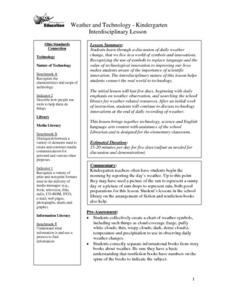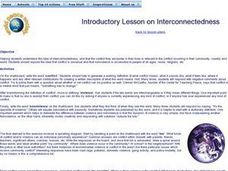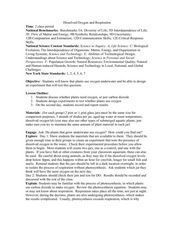Curated OER
Ecology Integration Using IMovie
Amazing! Any 5th grader would be more than willing to participate in this project. Students are broken into groups, each group reads one book from a list of five. They use their book as the basis for choosing an animal and environment to...
Curated OER
Learning from history: can it save lives?
Pupils research and document lessons learned from this disaster, then compile and synthesize information. They write effectively for public education purposes and use visual communications tools
Curated OER
LIVING WITHOUT WASTE - USE OF TIME
Students investigate the concept of time and how it is used. There are key words that can be used to stimulate thinking about how each is related to time. They take an inventory of how time is spent in a single day. Then students can...
Curated OER
Characteristics of Plants
For this characteristics of plants worksheet, students name two things that all plants have in common. Then they describe how the cell walls and cuticles help plants adapt to life on land. Students also explain the difference between...
Curated OER
The Wonderful Pigs of Jillian Jiggs
First graders compare fictional and real pigs. For this pig comparison lesson, 1st graders read a fiction text then a non-fiction text on pigs. Students complete a K-W-L chart and fill out a Venn Diagram.
Curated OER
Weather and Technology
Students discuss daily weather change, that we live in a world of symbols and innovations. They recognize the use of symbols to replace language and the value of technological innovation to improving our lives.
Curated OER
Ranger Rick's Notebook: Tree Time
In this Ranger Rick's notebook: tree time worksheet, 4th graders choose a tree to live in for a week (like a sloth), draw a picture of that world and write what they would do.
Curated OER
Mineralization
Learners investigate demineralization and remineralization and find common foods that promote these things. In this investigative lesson students compare effects of this on fluoride and non-fluoride treated substances and establish the...
Curated OER
Children's March Teacher's Guide, Activity 6
Learners explore the role of gender in the Civil Rights Movement. In this Children's March instructional activity, students watch "Mighty Time: The Children's March" and respond to the provided discussion questions that accompany it....
Curated OER
Theatre Lesson Plan: Finding Your Way
Second graders identify story elements in familiar stories from their lives. For this story elements lesson, 2nd graders act out familiar activities by following directions. Students read a story and discuss the story elements. Students...
Curated OER
Rodeo Time
Students use literature (the story Rodeo Time) and appropriate manipulatives to learn and understand mathematics. In these creative thinking measurement lessons, students have a focal point on problem solving strategies while using...
Curated OER
A Picture is Worth a Million Words
Students practice composing digital photographs by documenting activities in their lives. In this photography lesson, students utilize digital cameras to create beautiful art from things they find around the campus or at their home....
Curated OER
Introductory Lesson on Interconnectedness
Students are introduced to the concept of interconnectedness and make connections regarding conflict in their community, country, and the world. For this interconnectedness lesson plan, students define the word conflict and what that...
Curated OER
What Contains Carbon?
Students explore elements by analyzing everyday objects and materials in class. In this carbon lesson, students define several vocabulary terms such as carbon dioxide, hydrocarbon, and carbonate. Students view a group of items,...
University of Minnesota
C. elegans and the Search for Extraterrestrial Life
Introduce the topic of astrobiology in a unit that's out of this world. Biology scholars examine the search for extraterrestrial life by culturing roundworms, a species that has been key in helping researchers understand the challenges...
Curated OER
Outdoor Explorations: Mystery Plot Vacant Lot
Students utilize observations skills as they work together in groups to solve a mystery. They discuss and perform strategies to solve mysteries that occurred on a vacant lot. Students use a field guide to identify plants and animals...
Curated OER
Structure and Function of the Cell/Introduction to the Cell
So, this is not technically a learning exercise, but rather a chapter of reading material, pictures, and diagrams introducing young biologists to the cell. Cell theory, diversity, size, and shape are described. The internal organization...
Curated OER
Exploration of "Pillbugs"
Fifth graders define vocabulary terms, identify the characteristics of a pillbug, and create a dichotomous key. Then they examine the pillbugs and make observations and record these observations. Finally, 5th graders observe specific...
ARKive
Temperate Rainforest in the Pacific Northwest
Explore the amazing temperate rainforest of the Pacific Northwest. Your class starts by investigating the animals and plants of the Northwest, specifically Washington, and then research an animal population common to the area. In small...
Curated OER
Dissolved Oxygen and Respiration
Students are presented with the question, "Do plants that grow underwater use oxygen?" They create an experiment to test the presence of dissolved oxygen in the water using provided materials. Student experiments include a control jar as...
Curated OER
Tides in the Hudson
Students view an illustration of the Hudson River watershed and identify the bodies of water shown. They discuss what happens when fresh and salt water mix. Students view a teacher demonstration of the stratification of fresh and salt...
Curated OER
Change Since 1609
Students recognize how the climate of the Hudson Valley has changed since the last glaciation. They explain these changes using a reconstruction of the land use changes in the Hudson Valley composed of confetti, Ziploc bags and other...
Curated OER
Paleoclimate of the Hudson Valley
Students recognize how the climate of the Hudson Valley has changed since the last glaciation and be able to explain these changes. They reconstruct the paleoclimate of the Hudson Valley.
Alabama Learning Exchange
Good Litter, Bad Litter
Which ones can be thrown on the ground? Discover the difference between natural litter and unhealthy trash, helping scholars by using several examples. Use the information here to give them a basic background, but also encourage prior...
Other popular searches
- Non Living Things
- Non Living Organisms
- Non Living Things
- Laving and Non Living Things
- Lving and Non Living Things

























